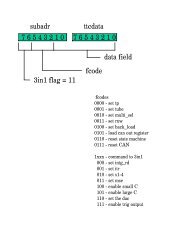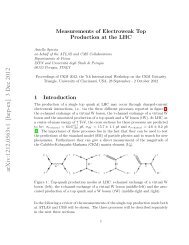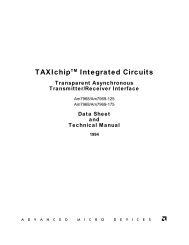Introduction to Sphalerons - High Energy Physics at The University ...
Introduction to Sphalerons - High Energy Physics at The University ...
Introduction to Sphalerons - High Energy Physics at The University ...
You also want an ePaper? Increase the reach of your titles
YUMPU automatically turns print PDFs into web optimized ePapers that Google loves.
<strong>Introduction</strong> <strong>to</strong> <strong>Sphalerons</strong><br />
Hridesh S. Kedia<br />
Department of <strong>Physics</strong><br />
<strong>University</strong> of Chicago<br />
Abstract<br />
<strong>Sphalerons</strong> are defined <strong>to</strong> be st<strong>at</strong>ic but unstable finite-energy solutions of the classical<br />
field equ<strong>at</strong>ions. This is a brief review of sphalerons and their significance in the Standard<br />
Model. <strong>The</strong> sphaleron solution for the SU(2) Yang–Mills–Higgs theory as derived in [2] is<br />
presented. <strong>The</strong> sphaleron is shown <strong>to</strong> have fractional charge and its role in baryon number<br />
nonconserv<strong>at</strong>ion is discussed. This work borrows heavily from [2].<br />
1
I. INTRODUCTION<br />
<strong>The</strong> word ‘sphaleron’ is of Greek origin and means “ready <strong>to</strong> fall”. <strong>Sphalerons</strong><br />
are st<strong>at</strong>ic unstable solutions of the classical field equ<strong>at</strong>ions with finite <strong>to</strong>tal energy<br />
of the fields. A sphaleron, being st<strong>at</strong>ic and localized in space, is particlelike but<br />
is unstable. <strong>The</strong> term ‘sphaleron’ was coined in [2] and used <strong>to</strong> describe st<strong>at</strong>ic,<br />
unstable solutions <strong>to</strong> the SU(2) Yang–Mills–Higgs theory.<br />
Unlike soli<strong>to</strong>ns, sphalerons do not correspond <strong>to</strong> particle excit<strong>at</strong>ions in the<br />
quantum theory since they are unstable solutions <strong>to</strong> the classical field equ<strong>at</strong>ions.<br />
<strong>Sphalerons</strong> separ<strong>at</strong>e <strong>to</strong>pologically distinct vacuum st<strong>at</strong>es, ie vacuum st<strong>at</strong>e in one<br />
gauge and vacuum st<strong>at</strong>e in another <strong>to</strong>pologically inequivalent gauge.<br />
Unfortun<strong>at</strong>ely all sphaleron solutions th<strong>at</strong> I have managed <strong>to</strong> find in the liter<strong>at</strong>ure<br />
are complic<strong>at</strong>ed and so I will present only one of the many sphaleron solutions, which<br />
is the sphaleron in the Yang–Mills–Higgs theory.<br />
II. SPHALERONS IN THE YANG–MILLS–HIGGS THEORY<br />
<strong>The</strong> sphaleron solution for the Yang–Mills–Higgs theory is a st<strong>at</strong>ic solution <strong>to</strong><br />
the classical field equ<strong>at</strong>ions, which is a saddle point of the energy functional and<br />
therefore unstable.<br />
Morse theory [8] tells us th<strong>at</strong> there is a connection between the <strong>to</strong>pology of a<br />
smooth manifold and the st<strong>at</strong>ionary points of an arbitrary smooth function defined<br />
on it. A standard example is a two-<strong>to</strong>rus standing on end, with the height above<br />
some reference plane the function defined on it (see Fig.. 1). <strong>The</strong> <strong>to</strong>pology of the<br />
<strong>to</strong>rus requires th<strong>at</strong> there must be <strong>at</strong>least two saddle points (only one of which is<br />
shown in the figure as the sphaleron S).<br />
Sphaleron S<br />
Vacuum<br />
FIG. 1: Sphaleron S on <strong>to</strong>p of a noncontractible loop in configur<strong>at</strong>ion space. <strong>The</strong> field<br />
energy is zero for the vacuum and positive for the sphaleron S.<br />
2
[1] shows th<strong>at</strong> in function space of all st<strong>at</strong>ic fields which are solutions <strong>to</strong> the clas-<br />
sical field equ<strong>at</strong>ions for the Yang–Mills–Higgs theory, there exists a noncontractible<br />
loop which begins and ends <strong>at</strong> the vacuum field configur<strong>at</strong>ion. <strong>The</strong>y go on <strong>to</strong> sug-<br />
gest th<strong>at</strong> a saddle-point solution exists for the Yang–Mills–Higgs theory, by a bold<br />
extension of the minimax idea by [6].<br />
In this article, we consider a simplified version of the electroweak Standard Model<br />
[7] without the hypercharge U(1) gauge field. This means, basically, th<strong>at</strong> we set the<br />
weak mixing angle θw ≡ arctan(g ′ /g) <strong>to</strong> zero, where g ′ and g are the coupling<br />
constants of the U(1) and SU(2) gauge groups, respectively. Also, we take only one<br />
family of quarks and lep<strong>to</strong>ns instead of the three known experimentally.<br />
<strong>The</strong> SU(2) Yang–Mills gauge field is denoted by Aµ(x) ≡ A a µ(x) τ a /(2i), where<br />
the τ a are the three Pauli m<strong>at</strong>rices acting on weak isospin space and the component<br />
fields A a µ(x) are real. (Repe<strong>at</strong>ed indices are summed over, unless st<strong>at</strong>ed otherwise.)<br />
<strong>The</strong> complex Higgs field transforms as an isodoublet under the SU(2) gauge group<br />
and is given by Φ(x) = (Φ1(x), Φ2(x)) t , where the suffix t stands for transpose.<br />
<strong>The</strong> classical action of the gauge and Higgs fields reads<br />
∫<br />
ΓYMH = d 4 x<br />
{<br />
1<br />
2 tr FµνF µν + (DµΦ) † (D µ (<br />
Φ) − λ Φ † Φ − 1<br />
2 v2<br />
) }<br />
2<br />
, (2.1)<br />
R 4<br />
where Fµν ≡ ∂µAν − ∂νAµ + g[Aµ, Aν] is the SU(2) Yang–Mills field strength<br />
and DµΦ ≡ (∂µ + gAµ)Φ the covariant deriv<strong>at</strong>ive of the Higgs field. <strong>The</strong> theory<br />
has Yang–Mills coupling constant g and quartic Higgs coupling constant λ, but<br />
the classical dynamics depends only on the r<strong>at</strong>io λ/g 2 . <strong>The</strong> parameter v has the<br />
dimension of mass and sets the scale of the Higgs expect<strong>at</strong>ion value. <strong>The</strong> three W<br />
vec<strong>to</strong>r bosons then have equal mass, MW = g v. <strong>The</strong> single Higgs scalar boson has<br />
a mass MH = 2 √ 2λ v .<br />
<strong>The</strong> action (2.1) is invariant under a local gauge transform<strong>at</strong>ion<br />
Φ ′ (x) = Λ(x) Φ(x) , gA ′ µ(x) = Λ(x) ( ) −1<br />
gAµ(x) + ∂µ Λ(x) , (2.2)<br />
for an arbitrary gauge function Λ(x) ∈ SU(2). In addition, there are certain global<br />
SU(2) and U(1) symmetry transform<strong>at</strong>ions which oper<strong>at</strong>e solely on the Higgs field.<br />
<strong>The</strong> field equ<strong>at</strong>ions are as follows:<br />
where<br />
( ) a 1<br />
DjFij = −<br />
2 ig<br />
[<br />
Φ † σ a DiΦ − (DiΦ) † σ a ]<br />
Φ<br />
( ) a<br />
DjFij = ∂jF a<br />
ij + gϵ abc W b j F c<br />
ij<br />
3<br />
(2.3)
and<br />
DiDiΦ = 2λ ( Φ † Φ − 1<br />
2 v2) Φ (2.4)<br />
In order <strong>to</strong> find a sphaleron, we look for a solution th<strong>at</strong> resembles the vacuum<br />
configur<strong>at</strong>ion as r → ∞ and use a rot<strong>at</strong>ed version of the ans<strong>at</strong>z used in [5]. Doing<br />
as st<strong>at</strong>ed above, we find th<strong>at</strong> a solution <strong>to</strong> these SU(2) equ<strong>at</strong>ions is possible with<br />
fields of the form<br />
and<br />
W a<br />
i σ a dx i = − 2ι<br />
g f(gvr)dU ∞ (U ∞ ) −1<br />
Φ = v √ h(gvr)U<br />
2 ∞<br />
( )<br />
0<br />
1<br />
where<br />
U ∞ = 1<br />
r<br />
(<br />
)<br />
z x + iy<br />
−x + iy z<br />
(2.5)<br />
(2.6)<br />
(2.7)<br />
It is convenient now <strong>to</strong> introduce the dimensionless radial distance ξ = gvr. <strong>The</strong><br />
radial functions f and h which appear in the solutions <strong>to</strong> the field equ<strong>at</strong>ions, are<br />
functions of ξ.<br />
For the fields 2.5, 2.6, the energy functional becomes<br />
E = 4πv<br />
g<br />
∫ ∞<br />
0<br />
[<br />
(<br />
df<br />
4<br />
dξ<br />
) 2<br />
<strong>The</strong> field equ<strong>at</strong>ions reduce <strong>to</strong><br />
+ 8<br />
ξ2 [f(1 − f)]2 + 1<br />
2 ξ2<br />
(<br />
dh<br />
dξ<br />
) 2<br />
+ [h(1 − f)] 2 + 1<br />
(<br />
λ<br />
4 g2 )<br />
ξ 2 (h 2 − 1) 2<br />
]<br />
dξ (2.8)<br />
ξ 2 d2f ξ2<br />
= 2f(1 − f)(1 − 2f) −<br />
dξ2 4 h2 (1 − f) (2.9)<br />
d<br />
(<br />
2 dh<br />
)<br />
ξ = 2h(1 − f)<br />
dξ dξ<br />
2 + λ<br />
g2 ξ2 (h 2 − 1)h (2.10)<br />
<strong>The</strong> boundary conditions on the functions f and h are the following. Near<br />
ξ = 0, f = αξ2 and h = βξ. As ξ → ∞, f = 1 − γexp(− 1ξ)<br />
and h =<br />
2<br />
1 − (δ/ξ)exp(− √ 2λ/g2ξ). α, β, γ, and δ are constants of order unity which can<br />
4
only be determined by finding the complete solutions which are given as Ans<strong>at</strong>z in<br />
[2].<br />
<strong>The</strong> solution of 2.9 and 2.10 minimizes the energy functional 2.8, but the solution<br />
is unstable with respect <strong>to</strong> fluctu<strong>at</strong>ions outside the class allowed by 2.5 and 2.6, which<br />
is why it is a saddle-point.<br />
III. FRACTIONAL CHARGE OF THE SPHALERON<br />
For each family of quarks and lep<strong>to</strong>ns, which we assume <strong>to</strong> be massless, there is<br />
a contribution <strong>to</strong> the divergence of the baryon current of the form<br />
∂µj µ 1<br />
B =<br />
32π2 ϵµνρσ ( 1<br />
2 g2F a µνF a ρσ + 1<br />
2 g′2fµνfρσ) (3.1)<br />
and equally for the divergence of the lep<strong>to</strong>n current. For simplicity, we will only<br />
consider the lightest family which consists of the u and d quarks, the electron and<br />
the electron-type neutrino.<br />
A consequence of 3.1 is th<strong>at</strong> if the gauge and Higgs fields are time dependent, then<br />
the baryonic charge is time dependent <strong>to</strong>o. If the fields traverse a noncontractible<br />
loop in configur<strong>at</strong>ion space, starting and finishing <strong>at</strong> the vacuum, with time as<br />
the parameter, then the baryonic charge changes by an integer. This integer is<br />
the Pontryagin index of the time-dependent gauge field, which equals the winding<br />
number of the loop in configur<strong>at</strong>ion space.<br />
Since the sphaleron represents a field configur<strong>at</strong>ion <strong>at</strong> the <strong>to</strong>p of the energy barrier<br />
between the vacuum in one gauge and the vacuum in a <strong>to</strong>pologically inequivalent<br />
gauge, one expects, if things are symmetrical, th<strong>at</strong> the sphaleron has baryonic charge<br />
1.<br />
This is the case as the calcul<strong>at</strong>ion in [2] shows.<br />
2<br />
<strong>The</strong> fact th<strong>at</strong> the sphaleron has baryonic charge 1<br />
2<br />
ties in nicely with the physical<br />
interpret<strong>at</strong>ion th<strong>at</strong> the sphaleron separ<strong>at</strong>es <strong>to</strong>pologically distinct vacua. Going by<br />
the two-<strong>to</strong>rus analogy, in configur<strong>at</strong>ion space, of all the homo<strong>to</strong>pically equivalent<br />
noncontractible loops th<strong>at</strong> connect two <strong>to</strong>pologically distinct vacua, the infimum of<br />
the maximal energy configur<strong>at</strong>ions on all such loops corresponds <strong>to</strong> the sphaleron.<br />
And the two <strong>to</strong>pologically distinct vacua have baryon charges 0 and 1, with the<br />
sphaleron having baryon charge 1.<br />
<strong>The</strong> energy of the sphaleron is the barrier energy<br />
2<br />
separ<strong>at</strong>ing the two vacua.<br />
5
IV. FINAL REMARKS<br />
Sphaleron configur<strong>at</strong>ions arise because of the non-trivial <strong>to</strong>pology of the config-<br />
ur<strong>at</strong>ion space of the classical field theory under consider<strong>at</strong>ion.<br />
Sphaleron configur<strong>at</strong>ions might play an important role in explaining baryon num-<br />
ber nonconserv<strong>at</strong>ion in systems <strong>at</strong> high temper<strong>at</strong>ure such as the early universe.<br />
<strong>Sphalerons</strong> can be used <strong>to</strong> explain baryon-number viol<strong>at</strong>ing processes even when a<br />
perturb<strong>at</strong>ive tre<strong>at</strong>ment may not be valid.<br />
Thus the study of sphalerons is extremely important <strong>to</strong> electroweak baryogenesis.<br />
[1] N.S. Man<strong>to</strong>n, “Topology in the Weinberg–Salam theory,” Phys. Rev. D 28 (1983)<br />
2019.<br />
[2] F.R. Klinkhamer and N.S. Man<strong>to</strong>n, “A saddle point solution in the Weinberg–Salam<br />
theory,” Phys. Rev. D 30 (1984) 2212.<br />
[3] F.R. Klinkhamer and C. Rupp, “<strong>Sphalerons</strong>, spectral flow, and anomalies,” J. M<strong>at</strong>h.<br />
Phys. 44 (2003) 8.<br />
[4] C.H. Taubes, “<strong>The</strong> existence of a non-minimal solution <strong>to</strong> the SU(2) Yang–Mills–Higgs<br />
equ<strong>at</strong>ions on R 3 ,” Commun. M<strong>at</strong>h. Phys. 86 (1982) 257; 86 (1982) 299;<br />
C.H. Taubes, “Min-max theory for the Yang–Mills–Higgs equ<strong>at</strong>ions,” Commun. M<strong>at</strong>h.<br />
Phys. 97 (1985) 473.<br />
[5] R. Dashen, B. Hasslacher and A. Neveu, “Nonperturb<strong>at</strong>ive methods and extended<br />
hadron models in field theory. III. Four-dimensional nonabelian models,” Phys. Rev.<br />
D 10 (1974) 4138.<br />
[6] L.A. Ljusternik, “<strong>The</strong> Topology of the Calculus of Vari<strong>at</strong>ions in the Large,” American<br />
M<strong>at</strong>h. Soc. (1966)<br />
[7] S.L. Glashow, “Partial symmetries of weak interactions,” Nucl. Phys. 22 (1961) 579;<br />
S. Weinberg, “A model of lep<strong>to</strong>ns,” Phys. Rev. Lett. 19 (1967) 1264;<br />
A. Salam, “Weak and electromagnetic interactions,” in: Elementary Particle <strong>The</strong>ory,<br />
edited by N. Svartholm (Almqvist, S<strong>to</strong>ckholm, 1968), p. 367;<br />
S.L. Glashow, J. Iliopoulos and L. Maiani, “Weak interactions with lep<strong>to</strong>n–hadron<br />
symmetry,” Phys. Rev. D 2 (1970) 1285.<br />
[8] J. Milnor, Morse <strong>The</strong>ory, Prince<strong>to</strong>n <strong>University</strong> Press, Prince<strong>to</strong>n, 1963.<br />
6



![arXiv:1308.5682v1 [astro-ph.HE] 26 Aug 2013 - High Energy ...](https://img.yumpu.com/21930938/1/190x245/arxiv13085682v1-astro-phhe-26-aug-2013-high-energy-.jpg?quality=85)




